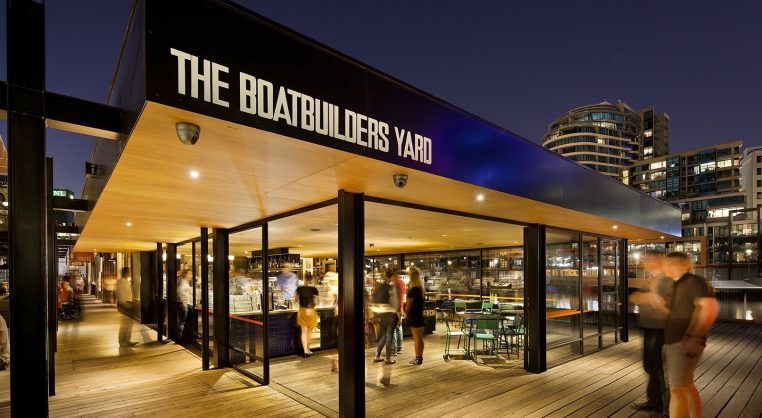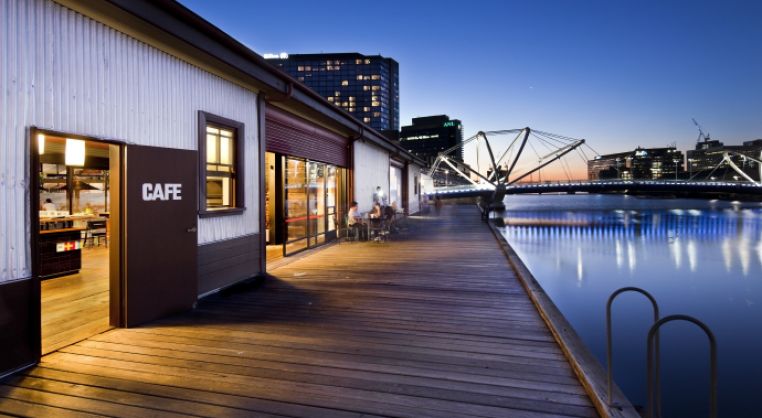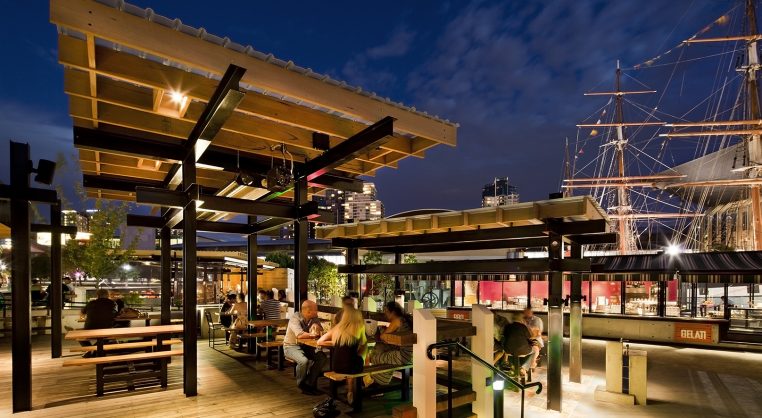The Boatbuilders Yard is a cafe and restaurant housed in Cargo Shed 4 in the South Wharf Maritime Precinct in Melbourne. In addition to retaining and reusing the shed, the project uses the scale and historic associations of the shed to reintroduce a ‘fine grain’ urban quality into an area that mostly operates as a largescale urban environment.
South Wharf has undergone major redevelopment in recent years, specifically through the construction of the new Melbourne Convention Centre and associated large-scale shopping, hotel and commercial facilities. Cargo Sheds 4–9 sit between these new buildings and the Yarra River in the newly landscaped South Wharf Promenade.
The adaptive reuse of the cargo sheds, conservation of the dry docks, and design of the riverside promenade formed part of the extended works associated with the convention centre.This sought to provide an appropriate context for the new buildings while also maintaining a link to the area’s maritime past.
The sheds sit on land owned by the was developed as part of a private/public partnership with Plenary Group. Located next to Duke’s and Orr’s Dry Dock, home to the barque Polly Woodside, Shed 4 sits separately to Sheds 5–9, and has been designed as distinct project within the precinct.
Download a printable version of the Boatbuilders Yard Case Study (PDF 562 KB).
Site history and heritage
Constructed in 1889 (Shed 9) and 1929–31 (Shed 4–8), the cargo sheds are described on the Victorian Heritage Register as “the last remaining link with the cargo and berthing facilities of the nineteenth century river port of Melbourne”.
In 1978, the National Trust took over Cargo Shed 4, and it became home to the volunteers working on the Polly Woodside and other historic boats stored on the premises.
Over the years, the building had been patched, painted and repainted and added to. It was in sound but deteriorating condition and the site was home to salvaged ship parts and other maritime objects. The sheds are listed on the Victorian Heritage Register.
Opportunities
Finding a compatible new, long-term use that would allow the building to be retained despite significant changes in its surrounding environment.
Challenges
To conserve the building, with all its signs of wear and tear, while meeting new building regulation requirements arising from the change of use.
The Section J requirement for building insulation was particularly challenging. Compliance would have required insulating and plastering the interior – this was avoided by arguing that the heritage value of the fabric took precedence.
Approach and outcome
The reuse project sought to put a viable use into the shed while preserving the building’s ability to tell a meaningful story of its past.
The fabric of the shed is retained as found wherever possible. The patina built up as the different uses marked the building – dented corrugated iron, exposed wall framing, nails, bolts, scrawled words – has been kept, hinting at the building’s previous lives and lending character to its new use.
This was possible because Cargo Shed 4 was retained in its entirety, leading to dispensations that meant the requirement to raise the shed above stipulated flood levels could be avoided. As a result the timber substructure and the timber piles, which supported half the building, could be retained in situ, along with the original timber structure and floor. This is in contrast to Sheds 5–9, which had to be rebuilt to meet regulatory requirements in relation to building regulations and river flood levels.
New pavilions and landscaping between the shed and the dry docks house the outdoor cafe functions. These are arranged in a way that maintains public access through the site, as part of the South Wharf Promenade, and encourages a new informal engagement with the dry docks.
These new elements are visually dominant when the shed is viewed from the land, but the reuse retains the clear connection between the heritage shed and the water’s edge.
Lessons
- A building that could have been dismissed as small and inconsequential, when compared with the major development around it, has been kept, thus retaining a layer of Melbourne’s important maritime history.
- The small scale of the heritage building is used to develop a new ‘fine grain’ urban environment that complements the large scale of the convention centre.
- Dispensations allowed the fabric of the building to be retained ‘as is’, thus keeping the building’s patina.
Project team
Architect: Six Degrees. Heritage: Bruce Trethowan. Building surveyor: Metro Building Surveyors. Builder: Tate Construction. External joinery: Goodsir & Otto. Services engineer: Wood Grieves Engineers. Structural engineer: Robyn Bleim & Associates. Landscape architects: I Love My Garden.




